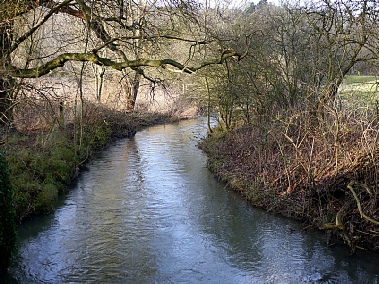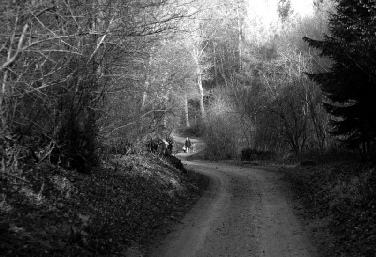THE MEANING OF EASNEYE
By Ron Dale
In every instance where the word ‘Easneye’ is mentioned in history books, its meaning
is quoted as water island. I do not always accept the popular theories and intend
to throw a spanner into the works here by suggesting that a study of ancient languages
and ancient dialects suggests this may not be correct. Nothing is ever certain with
place-names and most places can provide two or more versions of their origin. I believe
this to be the case for Easneye.
Whilst admitting that the vast wooded area that was once Easneye Park (now much
deforested) does have the river Ash tumbling down its hillside at Waters Place, this
river which is really a fast-flowing picturesque stream is located at the extremity
of the Easneye estate, bordering Widbury Hill in Ware. The main part of Easneye Woods
has the odd spring, but no significant flow of water through its trees. The only
decent flow of water is the stream of the Ash. There is evidence to show that the
Ash itself was once called the Iseneye and that the woods and the park adopted the
name later to become Easneye, but we do not wish to muddy the waters too much and
we must first concentrate on the meaning of Iseneye (13th century) or its modern
equivalent, Easneye.
Professor Helmut Gneuss, an expert in Anglo-Saxon language at Munich University,
states that the word for iron in Anglo-Saxon is found in three forms due to geographical
variations of dialect: isern, isen and iren. (The Origin of Standard Old English
and Aethelwold’s School at Winchester, Anglo-Saxon England, I, p.66, Helmut Gneuss,
1972). He stated that the form isen was in regular use during the Middle English
period, especially in the South East of England. In several ancient documents of
the 12th and 13th centuries Easneye may be seen as Iseneye or Isneye. German for
iron = eisen; Old Norse for iron = isarn; Middle English for iron = Ysen. Easneye
is also recorded in 13th century as Yseneye. I can accept that the second syllable
eye means island, giving us ‘island of iron’ if we take this meaning.
Carole Hough (In Isern in Place-Names, Studea Neupurogica, 6, pp. 145/147, 1995)
also mentions Easneye in Hertfordshire as one of several place names which contain
the Old English word for iron. She stated that ‘alternative etymologies might be
suggested for most, except in the case of Easneye and Isenwell (Gloucestershire)...
where there is good evidence for ironworks at or near their location.’ Unfortunately
she did not provide us with this evidence. Any archaeologists know of iron works
here?
And just to repeat a cliché, here comes another spanner. (Iron-Clad Evidence
in Early Medieval Dialectology). Hough’s view is that isen can also mean ‘kingfisher’
and she said there is evidence that Easneye was populated by this bird, a fact for
which I can personally testify even today if we consider Easneye to be the river
Ash. I have often enjoyed watching them diving for small fish in the Ash in the meadow
of Easneye Dairy Farm. I think we must be careful not to always accept an easy explanation
for the origin of a name, for example those of Easneye and Thele; and however unpopular
it might be, we do have to consider or perhaps just be aware of a possible alternative.
On the other hand, although Kingfisher Island does sounds rather grand, Easneye might
just mean water-meadow after all.
WHY RIVER ASH?
I have given this some thought and could not believe that a river which extends over
a approximately 16 miles could be named after a particular genus of tree. It certainly
does not have or ever could have ash trees along its full course. There has to be
some other explanation, I realised, but could not see one. Today I read of a place
in Gloucestershire called Ashbrook. Apparently in Old English it was called Estbroc,
the east brook. Est became Ast and then Ash. Broc became brook, hence Ashbrook. This
could also be the origin of our river Ash, the Eastern river? It certainly comes
into the area from the east. If both these spanners prove to be correct, we have
the East River flowing through Kingfisher Island. This is proof that it is always
best to turn to the old language of Anglo-Saxon when considering place names. Just
a thought.
R.D.

